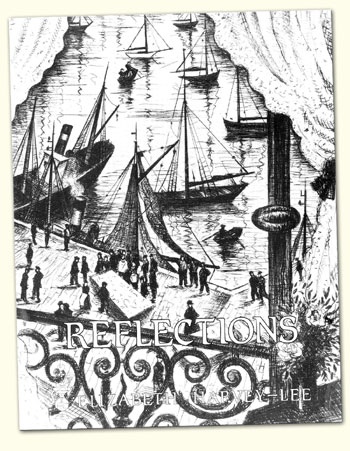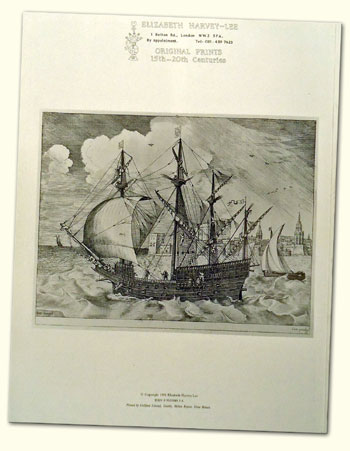|
REFLECTIONS
 Prints
of Boats & Rivers, Prints
of Boats & Rivers,
Ships & the Sea
It
is noticeable in this catalogue, which is ostensibly
a collection of marine prints, how few of the images
depict the sea. Is this because most artists are landlubbers?
There are instances of artists who were sailors or
had a practical knowledge of life at sea, such as Hollar,
Turner (who had himself strapped to the mast in a storm
to be able to witness its fury), Wyllie, Briscoe, McBey
and even, conversely, sailors who have become artists,
like Zeeman and his 19th century admirer Meryon.
The
imagery in artist’ original printmaking largely
ignores naval history, commercial overseas trade and
ship portraiture which are the raison d’être
of marine painting. These themes were expressed in
the decorative prints of the 18th and 19th century
produced by professional engravers who reproduced in
engraving, hand-coloured aquatint or tinted lithography
the subjects painted in oil or watercolours by specialist
marine painters. Artists who were original printmakers
responded more to the picturesque elements of boats,
to light on water, the romance of watery places like
Venice and Amsterdam, or portraits of ports such as
Marseilles or Naples where ships while inherent are
also incidental to the artistic composition. The great
river highways such as the Thames, the Elbe etc excited
artists’ imaginations as did the fishing paraphernalia
of small coastal harbours and the pleasures of the
beach and pier at seaside resorts. A number of the
artists’ colonies established in the later 19th
centuries were at coastal villages such as Cullercoats,
Staithes, Newlyn etc. The open sea had apparently less
to offer in the way of motifs for the black and white
graphic artist, as well as presenting practical difficulties
of working in physically unstable and potentially damp
surroundings.
The
earliest ship prints emanated from Antwerp and Venice
in a few examples at the end of the 15th century. They
were the two big maritime powers of their day and both
cities had the cultural ambience in which such prints
might be produced and appreciated. The potential was
recognised in the following century by the Antwerp
publisher Hieronymous Cock who commissioned Pieter
Brueghel the Elder to produce a series of drawings
of different ships to be published as engravings. These,
engraved by Frans Huys, are amongst the earliest fine
marine prints generally available. In the closing decades
of the 16th century the suppression of the revolt in
the southern Netherlands led to an artistic exodus
from Antwerp, which fell to the Spanish in 1585, and
a consequent artistic impetus in Amsterdam and other
cities in the newly independent northern United Provinces
of Holland. The importance of water and ships in the
golden age of Holland is reflected in the content of
artists’ etchings; particularly as the 17th century
progressed and tastes turned towards the secular and
a celebration of the financial success of a middle
class founded on maritime commerce. By the end of the
century artists such as Zeeman (as the etcher Reynier
Nooms was known) and Ludolf Backhuisen were specialising
in prints with a maritime theme.
 It
was in 17th century Holland too that the pleasure of
sailing as a pastime was first recognised. Charles
II when restored to the English throne brought with
him a love of yachts acquired in Holland. Yachting
however did not catch on till the 19th century when
the recreational value of coastal reaches was discovered
throughout Europe. Though on financial grounds sailing
as a pastime was largely confined to the upper classes,
the introduction of railway travel opened up seaside
resorts to the middle classes and working man (and
artist) who could enjoy the visual beauty of sail and
harbour, both in actuality and in recollection through
pictures and prints. Sailing and fishing boats and
harbours were a natural extension of the picturesque
and topographical tendencies developed in late 18th
and early 19th century art. It
was in 17th century Holland too that the pleasure of
sailing as a pastime was first recognised. Charles
II when restored to the English throne brought with
him a love of yachts acquired in Holland. Yachting
however did not catch on till the 19th century when
the recreational value of coastal reaches was discovered
throughout Europe. Though on financial grounds sailing
as a pastime was largely confined to the upper classes,
the introduction of railway travel opened up seaside
resorts to the middle classes and working man (and
artist) who could enjoy the visual beauty of sail and
harbour, both in actuality and in recollection through
pictures and prints. Sailing and fishing boats and
harbours were a natural extension of the picturesque
and topographical tendencies developed in late 18th
and early 19th century art.
In
the later 19th century modern development and improvements’ led
artists to appreciate the picturesqueness of the disappearing
scene and to record it for posterity. Whistler etched
the dereliction in Dickensian Wapping for his 'Thames
Set' of etchings, inspired not only artistically by
Meryon’s etchings of Paris and the Seine but
also historiographically by the impending plans for
the Thames embankment and redevelopment of the riverside
and docks. The concurrent trend was the recognition
and acceptance of realistically portrayed 19th century
urban working and middle class life as a new subject
suitable for art. Scenes of contemporary life which
included water and its refraction of light were particularly
appealing to the German impressionist printmakers such
as Liebermann and Oppenheimer.
Twentieth
century artists have delighted in all the foregoing
aspects of imagery of boats and water. While they instil
an understanding of the way of life of men and the
sea through passages of carefully observed detail such
as tackle, rigging and cut of prow, their prints also
express abstract concerns of light and form.
Published
1991
40 pages, 136 prints described and illustrated in black
and white
(Out of print)
|
|
Artists
included in the catalogue:
- Anderson
S.
- Ardizzone
E.
- Backhuisen
L.
- Béjot
E.
- Bentley
A.
- Blampied
E.
- Bone
M.
- Both
J.
- Bracquemond
F.
- Brangwyn
F.
- Briscoe
A.
- Brouet
A.
- Brueghel
P.
- Buhot
F.
- Cameron
D.Y.
- Chahine
E.
- Constable
J.
- Cooke
E.W.
- Corot
C.
- Cotman
J.S.
- Crome
J.
- Derksen
van Angeren A.
- Dodd
F.
- Dusart
C.
- Friedrich
A.
- Galton
A.
- Gaskell
P.
- Goff
R.
- Guillaumin
A.
- Haden
F.S.
- Hall
O.
- Hardie
M.
- Heriot
R.
- Hollar
W.
- Huys
F.
- Isabey
E.
- Janes
N.
- Kappel
P.
- Kasimir
L.
- Lalanne
M.
- Latenay
G. de
- Le
Bas J.P.
- Lee
S.
- Lepère
A.
- Liebermann
M.
- Lindsay
L.
- Litten
S.M.
- Lucas
D.
- Macbeth-Raeburn
H.
- Macnab
I.
- Maret
J.
- McBey
J.
- Meryon
C.
- Nevinson
C.R.W.
- Nieuwenkamp
W.O.J.
- Nolde
E.
- Nooms
R.
- Oppenheimer
J.
- Overlaet
A.
- Rademaker
A.
- Raverat
G.
- Richards
F.C.
- Robertson
D.
- Rushbury
H.
- Schmidt-Rottluff
K.
- Short
F.
- Sisley
A.
- Smart
D.I.
- Smetana
J.
- Sparks
N.
- Squirrell
L.R.
- Storm
van s’Gravensande C.
- Taylor
C.W.
- Ury
L.
- Vahrenhorst
P.
- Vernet
J.
- Verpilleux
E.A.
- Ward
L.
- Warren
E.B.
- Watson
C.J.
- Whistler
J.M.
- Wilson
E.
- Wyllie
W.L.
- Zeeman
R.
- Zwart
W. de
Return to the top |